Wastewater technology to assist nuclear clean-up

West Australian researchers have developed an advanced water decontamination process that turns toxic wastewater into near rainwater quality and which they believe could help Japan in its extensive clean-up of nuclear contaminated waters.
CSIRO scientist Grant Douglas visited the country in September and with assistance from Austrade has submitted a proposal to use CSIRO's Virtual Curtain technology for widespread remediation work in Japan, estimated to be worth hundreds of millions of dollars.
He says water tanks, flooded buildings and basements in Fukushima remain highly contaminated after the meltdown of the power plant nuclear reactors in 2011.
"They need to clean those up and that's proving difficult because they have such a wide range of contaminants," Dr Douglas says.
"They can't generally employ one technique—they need multiple ones, whereas our technology has the advantage that it can clean up a lot of contaminants in one step."
Dr Douglas says the first full scale application of the technology in Australia began in late September at a toxic mine site in Queensland.
"This is a severe environmental liability at the moment; what we'll be doing is treating water that's highly acidic and full of all sorts of toxic metals metalloids, arsenic and other things," he says.
"The water we produce from that is virtually drinking-quality except for the salt level.
"That is then going through a reverse osmosis plant to remove the salt and that effluent – which will be released into a river – is actually going to be better quality water than is now in the river. It'll be like rainwater."
The Virtual Curtain technology is patented by CSIRO and made commercial through the company Virtual Curtain Limited.
It uses hydrotalcites; layered minerals consisting of aluminium and magnesium-rich-layers, separated by interlayers of anions (negatively charged molecules like sulphate).
During the process the aluminium and magnesium can be replaced by a range of other metals like copper and lead as the hydotalcites form. The metals and anions are then trapped and easily removed from wastewater as a solid.
Dr Douglas says lime has been used traditionally to decontaminate wastewater but among its drawbacks it requires a number of complex steps and produces enormous amounts of sludge.
"The technique I have produces just 10 per cent or less of the sludge that lime does which is then far more concentrated as a result, and has potential to turn what was wastewater back into an ore; they can re-mine it."
Provided by Science Network WA



















